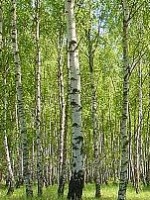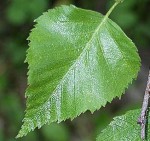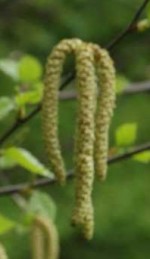 This native of Europe and Asia, also known as silver birch, is a deciduous tree up to 100’ tall in the wild but 40-60’ in cultivation. It has warty twigs and white exfoliating bark with black vertical fissures. The trees have an upright main trunk usually with pendulous branches and twigs that give it a soft and graceful appearance. The simple leaves have doubly serrated margins and are dotted with glands. The are bright green in the spring turning dark green in the summer and then yellow in the fall. Male and female catkins appear on the same tree in spring. The male catkins are dangle down usually in 2’s but also singly and in 3’s, while the female are erect and single. European white birch are outstanding as specimens, in groves, and make a good shade tree. It prefers cool temperatures as may have pest problems when grown in too warm a climate. Snow and ice can cause damage but even under the best conditions European white birch may be short lived.
This native of Europe and Asia, also known as silver birch, is a deciduous tree up to 100’ tall in the wild but 40-60’ in cultivation. It has warty twigs and white exfoliating bark with black vertical fissures. The trees have an upright main trunk usually with pendulous branches and twigs that give it a soft and graceful appearance. The simple leaves have doubly serrated margins and are dotted with glands. The are bright green in the spring turning dark green in the summer and then yellow in the fall. Male and female catkins appear on the same tree in spring. The male catkins are dangle down usually in 2’s but also singly and in 3’s, while the female are erect and single. European white birch are outstanding as specimens, in groves, and make a good shade tree. It prefers cool temperatures as may have pest problems when grown in too warm a climate. Snow and ice can cause damage but even under the best conditions European white birch may be short lived.
Type: Deciduous tree
Outstanding Feature: Bark
Form: Pyramidal when young; rounded, pendulous with maturity
Growth Rate: Moderate to rapid
 Bloom: Male and female catkins in April; male catkins loose, dangle down usually in 2’s, also singly and in 3’s; female catkins erect and single.
Bloom: Male and female catkins in April; male catkins loose, dangle down usually in 2’s, also singly and in 3’s; female catkins erect and single.
Size: 40-60’ H x 10-20’ W
Light: Full sun

Soil: Average, moist, well-drained; tolerates some dryness
Hardiness: Zones 2-7
Care: Do not prune in the spring as the cut branch will “bleed” profusely
Pests and Diseases: Bronze birch borer, birch leafminer, aphids.
Propagation: Seed; cultivars by grafting
Outstanding Cultivars:

- ‘Fastigiata’ (Columnar)

- ‘Gracilis’ (Finely dissected leaves)

- ‘Purple Splender’ (Reddish purple foliage)
